Machine Learning Methods and Applications in Data Science, ITS 531
VerifiedAdded on 2022/08/20
|7
|1400
|14
Essay
AI Summary
This essay provides a comprehensive overview of machine learning, differentiating between supervised and unsupervised learning methods. It explores the functionalities of Artificial Neural Networks (ANNs) within supervised learning, explaining their role in predicting outcomes. The essay illustrates the concepts with practical, real-world examples, such as regression and classification in supervised learning, and clustering and association/reduction in unsupervised learning. Additionally, the essay references scholarly sources to support its findings, adhering to APA 6th edition style guidelines.
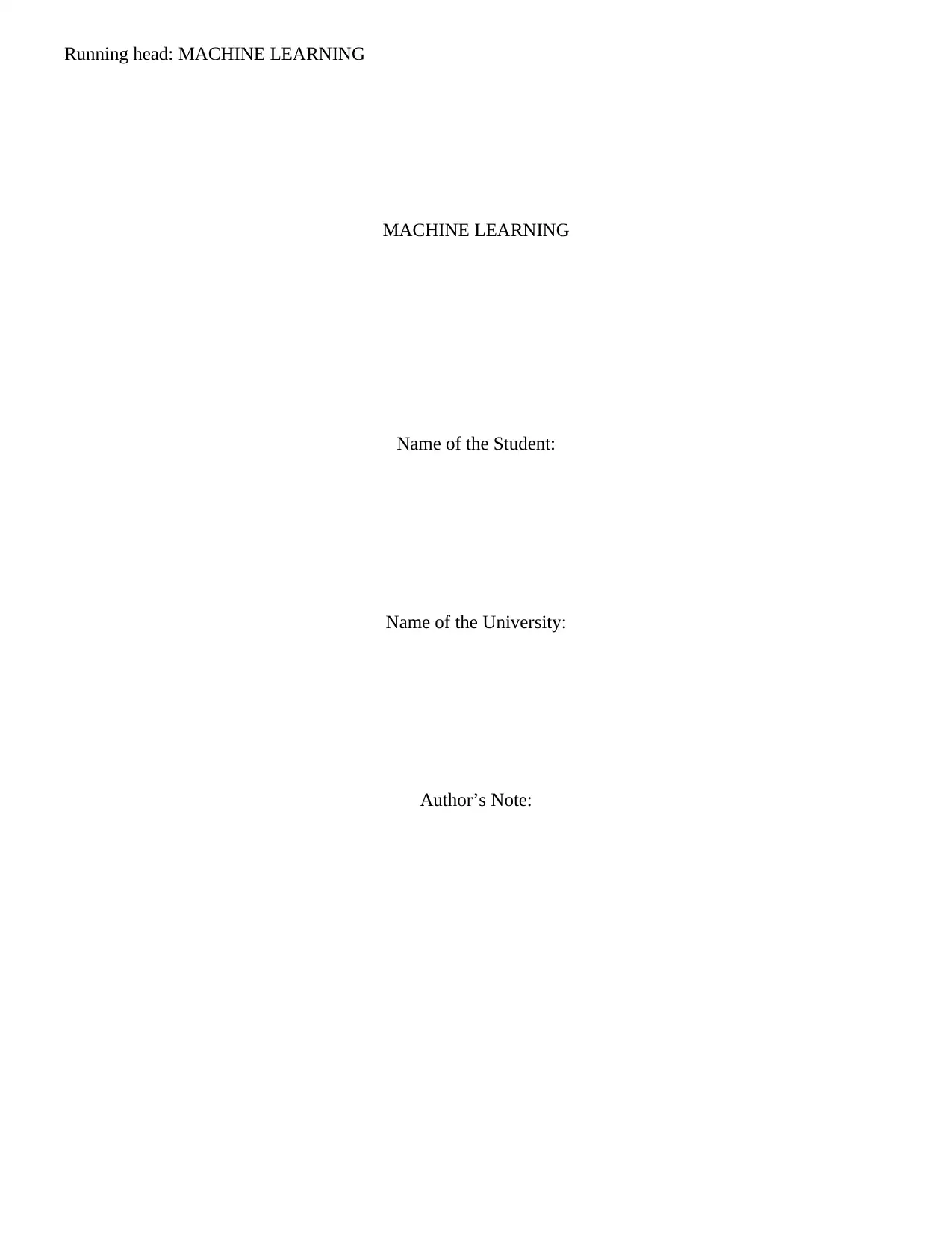
Running head: MACHINE LEARNING
MACHINE LEARNING
Name of the Student:
Name of the University:
Author’s Note:
MACHINE LEARNING
Name of the Student:
Name of the University:
Author’s Note:
Paraphrase This Document
Need a fresh take? Get an instant paraphrase of this document with our AI Paraphraser
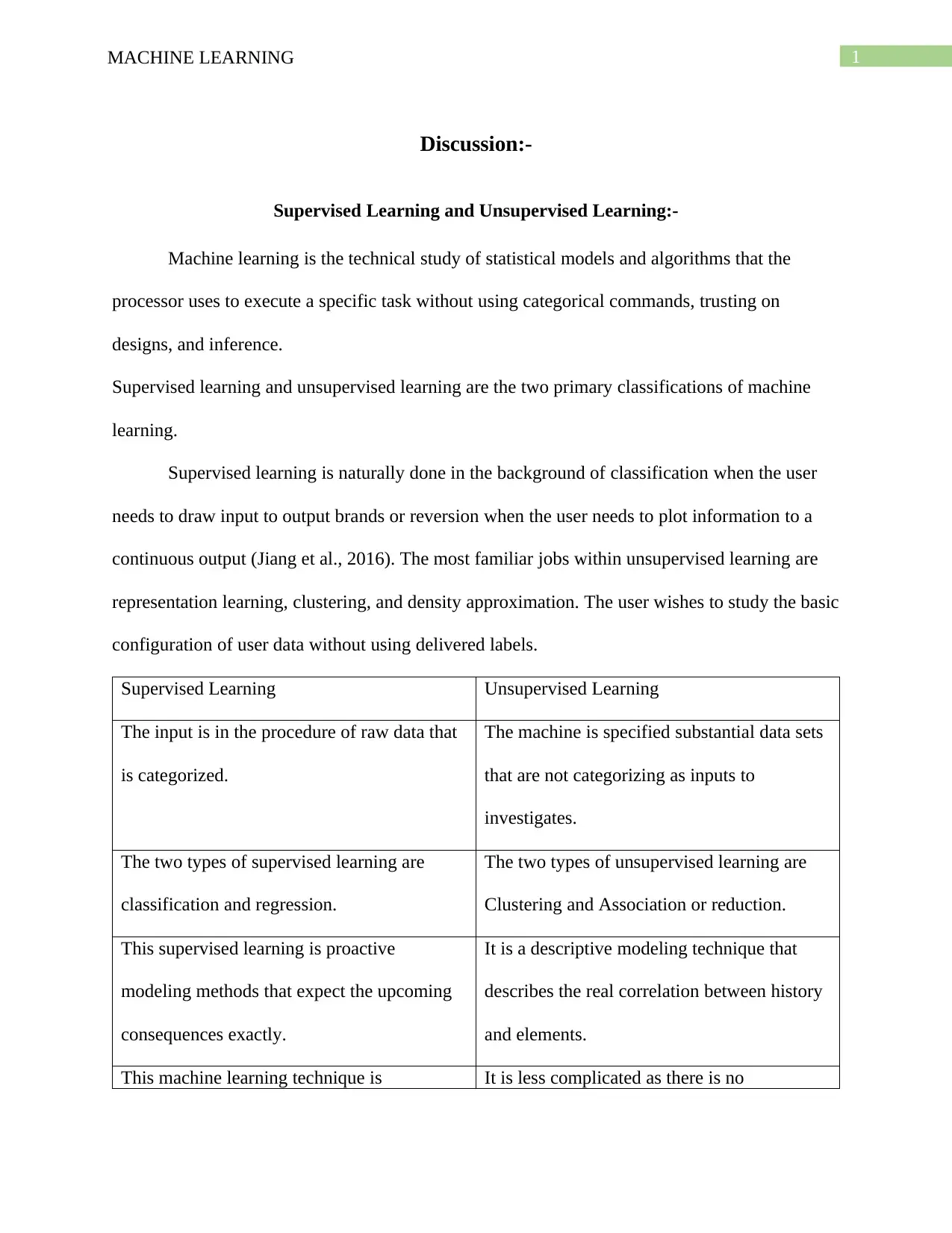
1MACHINE LEARNING
Discussion:-
Supervised Learning and Unsupervised Learning:-
Machine learning is the technical study of statistical models and algorithms that the
processor uses to execute a specific task without using categorical commands, trusting on
designs, and inference.
Supervised learning and unsupervised learning are the two primary classifications of machine
learning.
Supervised learning is naturally done in the background of classification when the user
needs to draw input to output brands or reversion when the user needs to plot information to a
continuous output (Jiang et al., 2016). The most familiar jobs within unsupervised learning are
representation learning, clustering, and density approximation. The user wishes to study the basic
configuration of user data without using delivered labels.
Supervised Learning Unsupervised Learning
The input is in the procedure of raw data that
is categorized.
The machine is specified substantial data sets
that are not categorizing as inputs to
investigates.
The two types of supervised learning are
classification and regression.
The two types of unsupervised learning are
Clustering and Association or reduction.
This supervised learning is proactive
modeling methods that expect the upcoming
consequences exactly.
It is a descriptive modeling technique that
describes the real correlation between history
and elements.
This machine learning technique is It is less complicated as there is no
Discussion:-
Supervised Learning and Unsupervised Learning:-
Machine learning is the technical study of statistical models and algorithms that the
processor uses to execute a specific task without using categorical commands, trusting on
designs, and inference.
Supervised learning and unsupervised learning are the two primary classifications of machine
learning.
Supervised learning is naturally done in the background of classification when the user
needs to draw input to output brands or reversion when the user needs to plot information to a
continuous output (Jiang et al., 2016). The most familiar jobs within unsupervised learning are
representation learning, clustering, and density approximation. The user wishes to study the basic
configuration of user data without using delivered labels.
Supervised Learning Unsupervised Learning
The input is in the procedure of raw data that
is categorized.
The machine is specified substantial data sets
that are not categorizing as inputs to
investigates.
The two types of supervised learning are
classification and regression.
The two types of unsupervised learning are
Clustering and Association or reduction.
This supervised learning is proactive
modeling methods that expect the upcoming
consequences exactly.
It is a descriptive modeling technique that
describes the real correlation between history
and elements.
This machine learning technique is It is less complicated as there is no
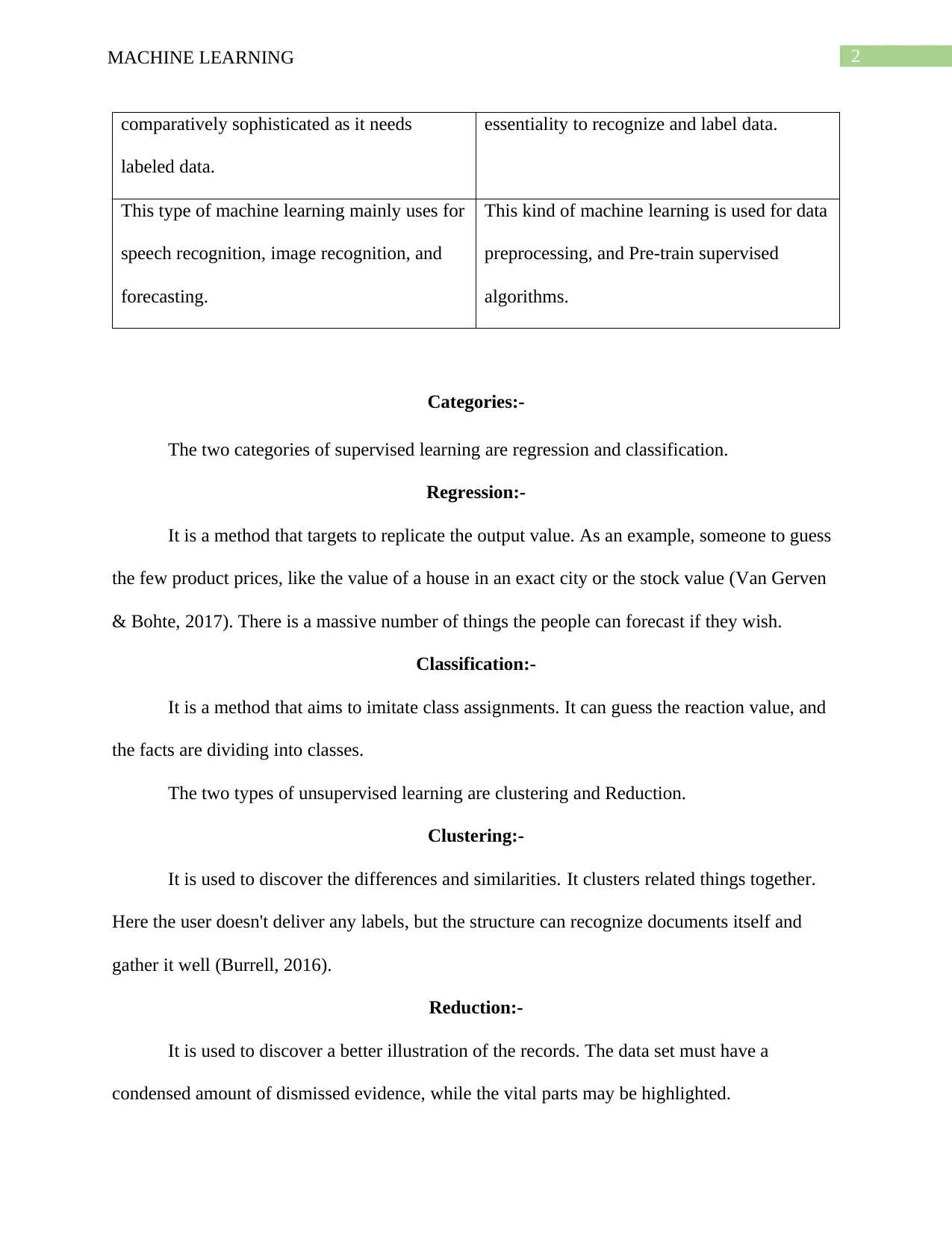
2MACHINE LEARNING
comparatively sophisticated as it needs
labeled data.
essentiality to recognize and label data.
This type of machine learning mainly uses for
speech recognition, image recognition, and
forecasting.
This kind of machine learning is used for data
preprocessing, and Pre-train supervised
algorithms.
Categories:-
The two categories of supervised learning are regression and classification.
Regression:-
It is a method that targets to replicate the output value. As an example, someone to guess
the few product prices, like the value of a house in an exact city or the stock value (Van Gerven
& Bohte, 2017). There is a massive number of things the people can forecast if they wish.
Classification:-
It is a method that aims to imitate class assignments. It can guess the reaction value, and
the facts are dividing into classes.
The two types of unsupervised learning are clustering and Reduction.
Clustering:-
It is used to discover the differences and similarities. It clusters related things together.
Here the user doesn't deliver any labels, but the structure can recognize documents itself and
gather it well (Burrell, 2016).
Reduction:-
It is used to discover a better illustration of the records. The data set must have a
condensed amount of dismissed evidence, while the vital parts may be highlighted.
comparatively sophisticated as it needs
labeled data.
essentiality to recognize and label data.
This type of machine learning mainly uses for
speech recognition, image recognition, and
forecasting.
This kind of machine learning is used for data
preprocessing, and Pre-train supervised
algorithms.
Categories:-
The two categories of supervised learning are regression and classification.
Regression:-
It is a method that targets to replicate the output value. As an example, someone to guess
the few product prices, like the value of a house in an exact city or the stock value (Van Gerven
& Bohte, 2017). There is a massive number of things the people can forecast if they wish.
Classification:-
It is a method that aims to imitate class assignments. It can guess the reaction value, and
the facts are dividing into classes.
The two types of unsupervised learning are clustering and Reduction.
Clustering:-
It is used to discover the differences and similarities. It clusters related things together.
Here the user doesn't deliver any labels, but the structure can recognize documents itself and
gather it well (Burrell, 2016).
Reduction:-
It is used to discover a better illustration of the records. The data set must have a
condensed amount of dismissed evidence, while the vital parts may be highlighted.
⊘ This is a preview!⊘
Do you want full access?
Subscribe today to unlock all pages.

Trusted by 1+ million students worldwide
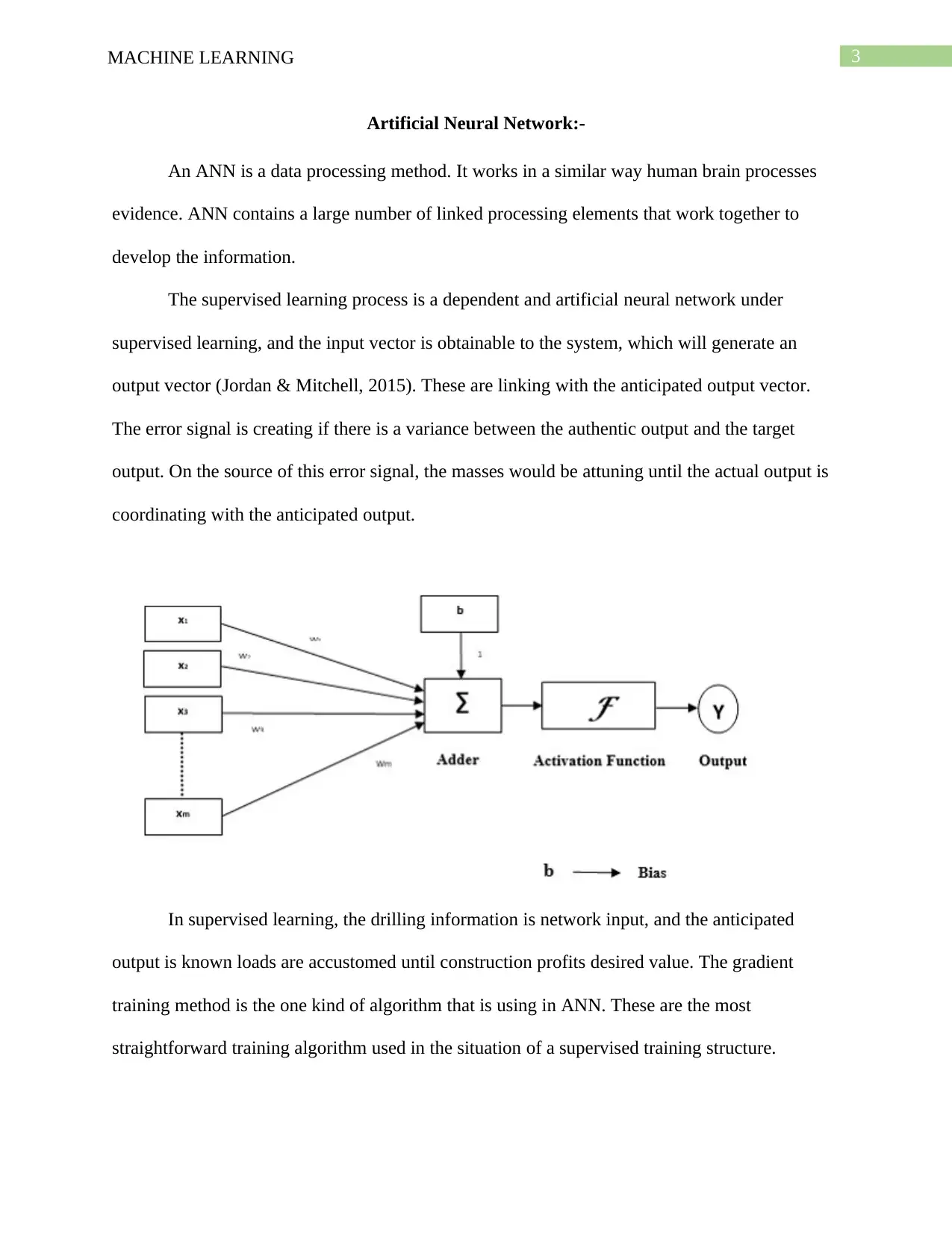
3MACHINE LEARNING
Artificial Neural Network:-
An ANN is a data processing method. It works in a similar way human brain processes
evidence. ANN contains a large number of linked processing elements that work together to
develop the information.
The supervised learning process is a dependent and artificial neural network under
supervised learning, and the input vector is obtainable to the system, which will generate an
output vector (Jordan & Mitchell, 2015). These are linking with the anticipated output vector.
The error signal is creating if there is a variance between the authentic output and the target
output. On the source of this error signal, the masses would be attuning until the actual output is
coordinating with the anticipated output.
In supervised learning, the drilling information is network input, and the anticipated
output is known loads are accustomed until construction profits desired value. The gradient
training method is the one kind of algorithm that is using in ANN. These are the most
straightforward training algorithm used in the situation of a supervised training structure.
Artificial Neural Network:-
An ANN is a data processing method. It works in a similar way human brain processes
evidence. ANN contains a large number of linked processing elements that work together to
develop the information.
The supervised learning process is a dependent and artificial neural network under
supervised learning, and the input vector is obtainable to the system, which will generate an
output vector (Jordan & Mitchell, 2015). These are linking with the anticipated output vector.
The error signal is creating if there is a variance between the authentic output and the target
output. On the source of this error signal, the masses would be attuning until the actual output is
coordinating with the anticipated output.
In supervised learning, the drilling information is network input, and the anticipated
output is known loads are accustomed until construction profits desired value. The gradient
training method is the one kind of algorithm that is using in ANN. These are the most
straightforward training algorithm used in the situation of a supervised training structure.
Paraphrase This Document
Need a fresh take? Get an instant paraphrase of this document with our AI Paraphraser
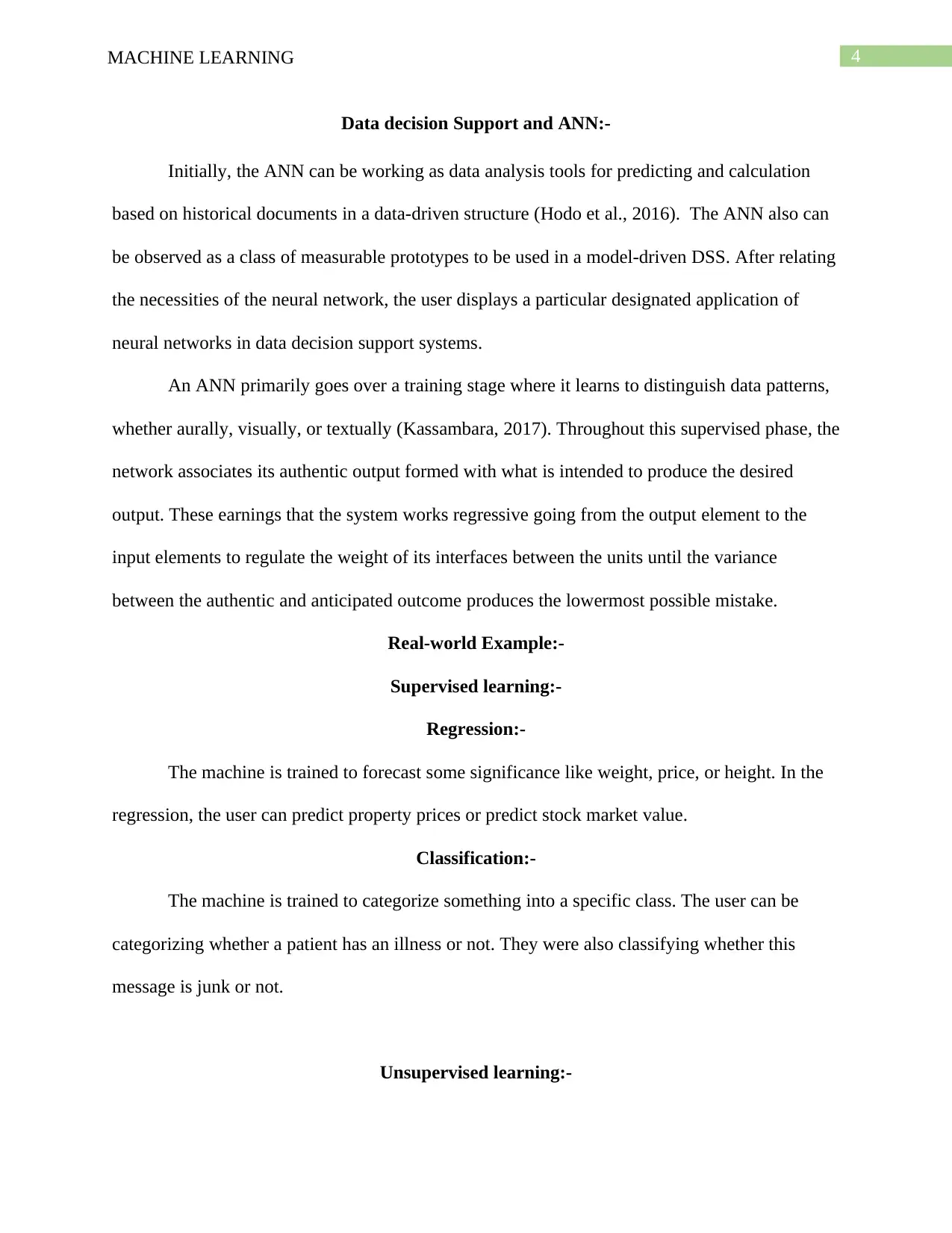
4MACHINE LEARNING
Data decision Support and ANN:-
Initially, the ANN can be working as data analysis tools for predicting and calculation
based on historical documents in a data-driven structure (Hodo et al., 2016). The ANN also can
be observed as a class of measurable prototypes to be used in a model-driven DSS. After relating
the necessities of the neural network, the user displays a particular designated application of
neural networks in data decision support systems.
An ANN primarily goes over a training stage where it learns to distinguish data patterns,
whether aurally, visually, or textually (Kassambara, 2017). Throughout this supervised phase, the
network associates its authentic output formed with what is intended to produce the desired
output. These earnings that the system works regressive going from the output element to the
input elements to regulate the weight of its interfaces between the units until the variance
between the authentic and anticipated outcome produces the lowermost possible mistake.
Real-world Example:-
Supervised learning:-
Regression:-
The machine is trained to forecast some significance like weight, price, or height. In the
regression, the user can predict property prices or predict stock market value.
Classification:-
The machine is trained to categorize something into a specific class. The user can be
categorizing whether a patient has an illness or not. They were also classifying whether this
message is junk or not.
Unsupervised learning:-
Data decision Support and ANN:-
Initially, the ANN can be working as data analysis tools for predicting and calculation
based on historical documents in a data-driven structure (Hodo et al., 2016). The ANN also can
be observed as a class of measurable prototypes to be used in a model-driven DSS. After relating
the necessities of the neural network, the user displays a particular designated application of
neural networks in data decision support systems.
An ANN primarily goes over a training stage where it learns to distinguish data patterns,
whether aurally, visually, or textually (Kassambara, 2017). Throughout this supervised phase, the
network associates its authentic output formed with what is intended to produce the desired
output. These earnings that the system works regressive going from the output element to the
input elements to regulate the weight of its interfaces between the units until the variance
between the authentic and anticipated outcome produces the lowermost possible mistake.
Real-world Example:-
Supervised learning:-
Regression:-
The machine is trained to forecast some significance like weight, price, or height. In the
regression, the user can predict property prices or predict stock market value.
Classification:-
The machine is trained to categorize something into a specific class. The user can be
categorizing whether a patient has an illness or not. They were also classifying whether this
message is junk or not.
Unsupervised learning:-
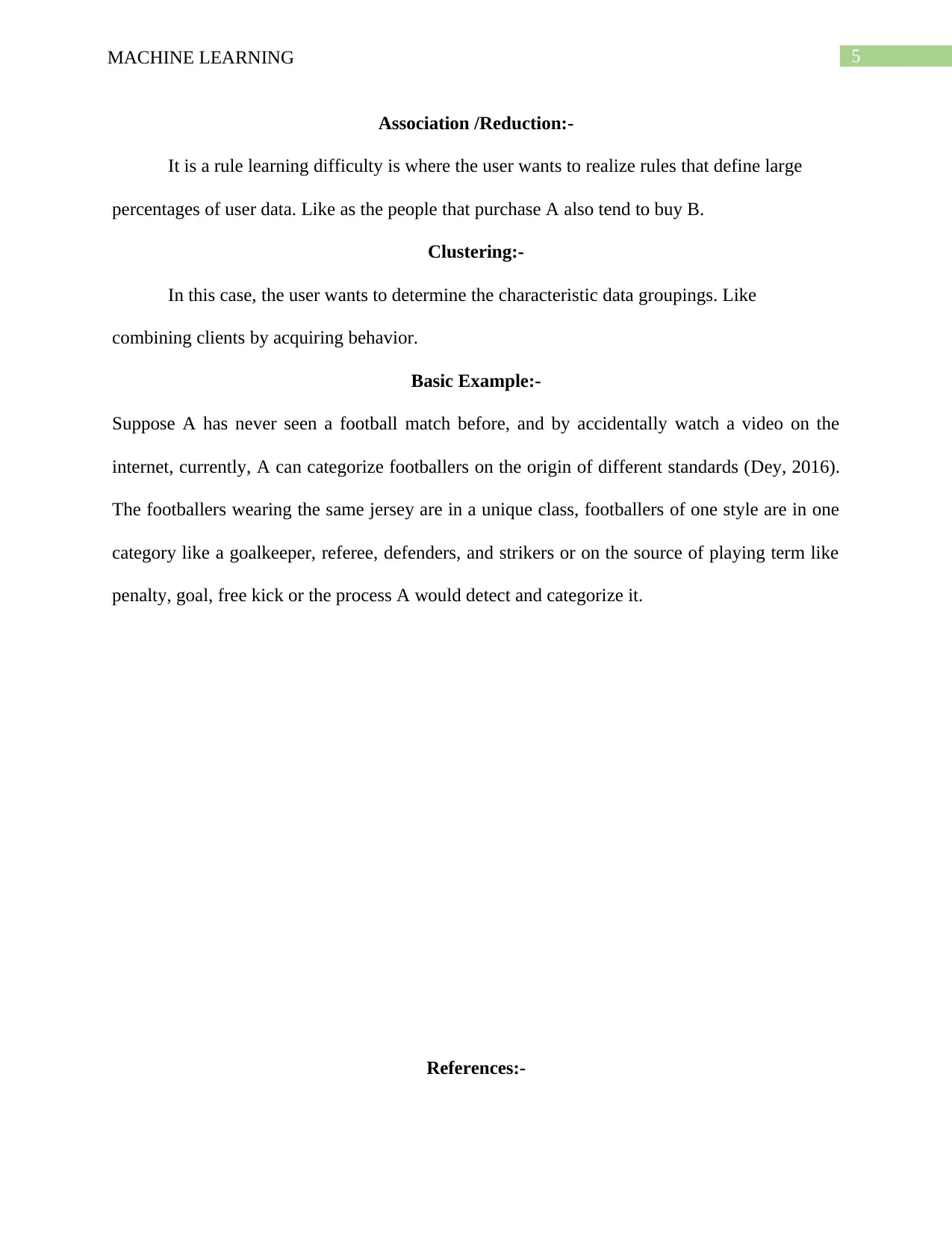
5MACHINE LEARNING
Association /Reduction:-
It is a rule learning difficulty is where the user wants to realize rules that define large
percentages of user data. Like as the people that purchase A also tend to buy B.
Clustering:-
In this case, the user wants to determine the characteristic data groupings. Like
combining clients by acquiring behavior.
Basic Example:-
Suppose A has never seen a football match before, and by accidentally watch a video on the
internet, currently, A can categorize footballers on the origin of different standards (Dey, 2016).
The footballers wearing the same jersey are in a unique class, footballers of one style are in one
category like a goalkeeper, referee, defenders, and strikers or on the source of playing term like
penalty, goal, free kick or the process A would detect and categorize it.
References:-
Association /Reduction:-
It is a rule learning difficulty is where the user wants to realize rules that define large
percentages of user data. Like as the people that purchase A also tend to buy B.
Clustering:-
In this case, the user wants to determine the characteristic data groupings. Like
combining clients by acquiring behavior.
Basic Example:-
Suppose A has never seen a football match before, and by accidentally watch a video on the
internet, currently, A can categorize footballers on the origin of different standards (Dey, 2016).
The footballers wearing the same jersey are in a unique class, footballers of one style are in one
category like a goalkeeper, referee, defenders, and strikers or on the source of playing term like
penalty, goal, free kick or the process A would detect and categorize it.
References:-
⊘ This is a preview!⊘
Do you want full access?
Subscribe today to unlock all pages.

Trusted by 1+ million students worldwide
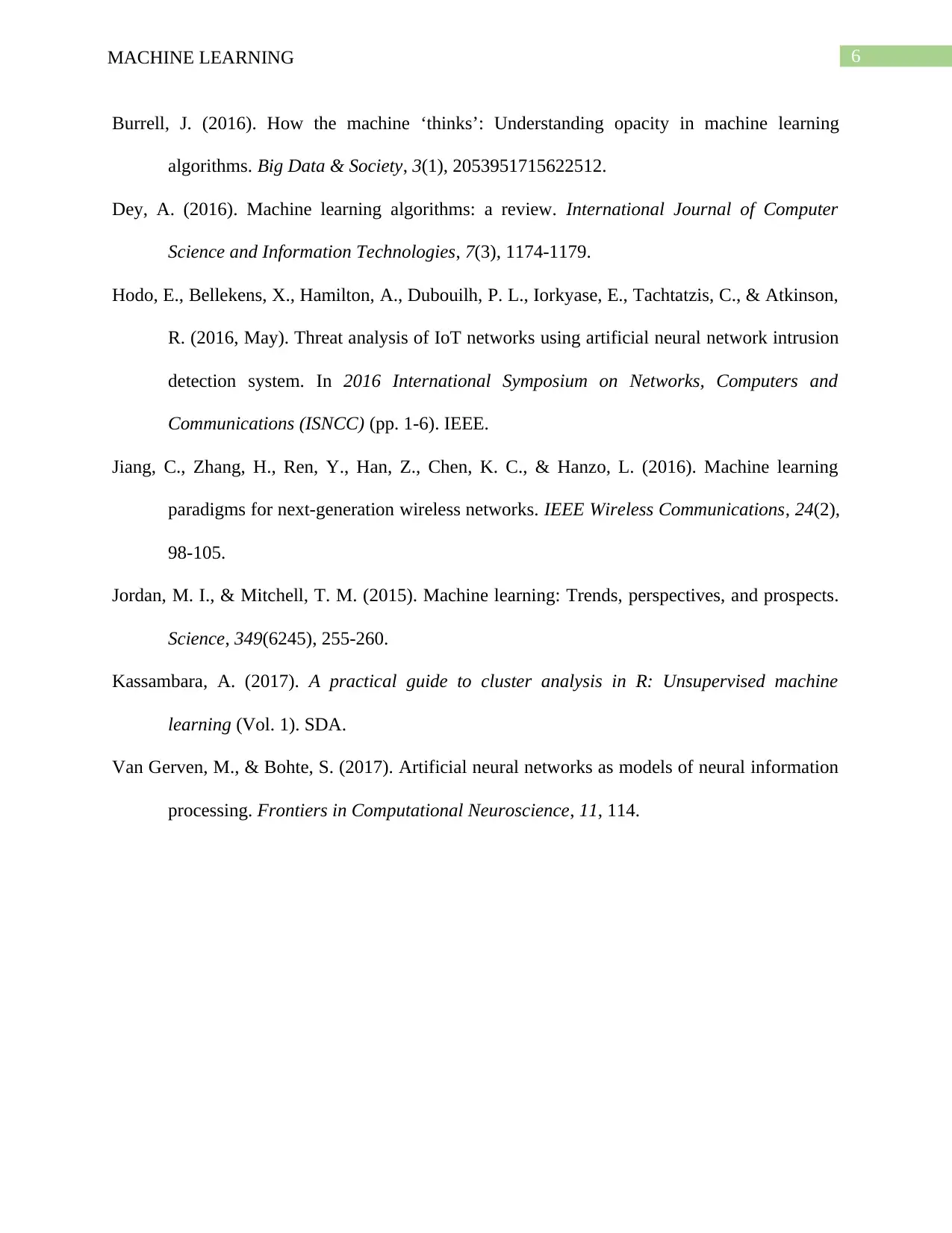
6MACHINE LEARNING
Burrell, J. (2016). How the machine ‘thinks’: Understanding opacity in machine learning
algorithms. Big Data & Society, 3(1), 2053951715622512.
Dey, A. (2016). Machine learning algorithms: a review. International Journal of Computer
Science and Information Technologies, 7(3), 1174-1179.
Hodo, E., Bellekens, X., Hamilton, A., Dubouilh, P. L., Iorkyase, E., Tachtatzis, C., & Atkinson,
R. (2016, May). Threat analysis of IoT networks using artificial neural network intrusion
detection system. In 2016 International Symposium on Networks, Computers and
Communications (ISNCC) (pp. 1-6). IEEE.
Jiang, C., Zhang, H., Ren, Y., Han, Z., Chen, K. C., & Hanzo, L. (2016). Machine learning
paradigms for next-generation wireless networks. IEEE Wireless Communications, 24(2),
98-105.
Jordan, M. I., & Mitchell, T. M. (2015). Machine learning: Trends, perspectives, and prospects.
Science, 349(6245), 255-260.
Kassambara, A. (2017). A practical guide to cluster analysis in R: Unsupervised machine
learning (Vol. 1). SDA.
Van Gerven, M., & Bohte, S. (2017). Artificial neural networks as models of neural information
processing. Frontiers in Computational Neuroscience, 11, 114.
Burrell, J. (2016). How the machine ‘thinks’: Understanding opacity in machine learning
algorithms. Big Data & Society, 3(1), 2053951715622512.
Dey, A. (2016). Machine learning algorithms: a review. International Journal of Computer
Science and Information Technologies, 7(3), 1174-1179.
Hodo, E., Bellekens, X., Hamilton, A., Dubouilh, P. L., Iorkyase, E., Tachtatzis, C., & Atkinson,
R. (2016, May). Threat analysis of IoT networks using artificial neural network intrusion
detection system. In 2016 International Symposium on Networks, Computers and
Communications (ISNCC) (pp. 1-6). IEEE.
Jiang, C., Zhang, H., Ren, Y., Han, Z., Chen, K. C., & Hanzo, L. (2016). Machine learning
paradigms for next-generation wireless networks. IEEE Wireless Communications, 24(2),
98-105.
Jordan, M. I., & Mitchell, T. M. (2015). Machine learning: Trends, perspectives, and prospects.
Science, 349(6245), 255-260.
Kassambara, A. (2017). A practical guide to cluster analysis in R: Unsupervised machine
learning (Vol. 1). SDA.
Van Gerven, M., & Bohte, S. (2017). Artificial neural networks as models of neural information
processing. Frontiers in Computational Neuroscience, 11, 114.
1 out of 7
Related Documents
Your All-in-One AI-Powered Toolkit for Academic Success.
+13062052269
info@desklib.com
Available 24*7 on WhatsApp / Email
![[object Object]](/_next/static/media/star-bottom.7253800d.svg)
Unlock your academic potential
Copyright © 2020–2025 A2Z Services. All Rights Reserved. Developed and managed by ZUCOL.





